Development

Consistent Collisions, James Webb, & Planetscaping Tweaks | Update 29.1
Jan 27th
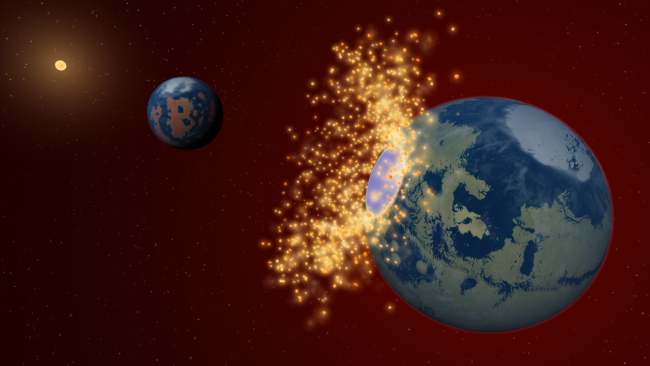
Run Steam to download Update 29.1, or buy Universe Sandbox via our website or the Steam Store.
Update 29.1
Planetscaping now has an eyedropper tool to sample the surface of an object to make creating (or flooding) land even smoother. We’ve also improved fragmentation during collisions, among other things.
Fragmentation
We’ve updated how we determine the number of fragments during collisions. This allows fragments to last longer in simulations with numerous collisions and makes collisions more consistent across different simulation speeds.
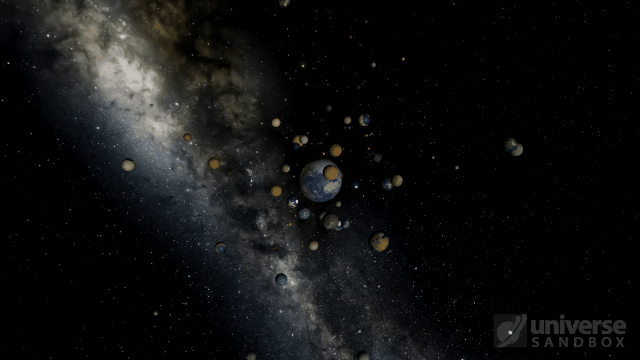
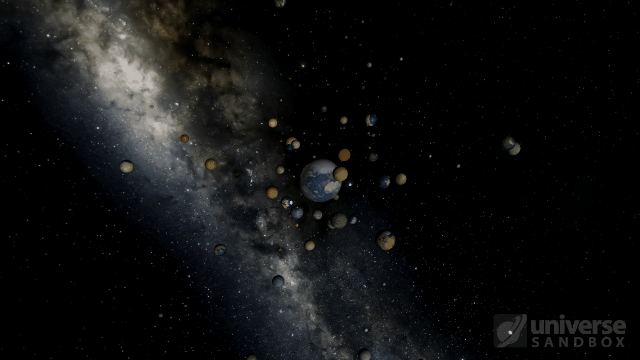
Planetscaping Eyedropper
There’s now an eyedropper in the Planetscaping tool so you can easily sample and set the Depth, Temperature, and Pressure to match those of the object you are Planetscaping.
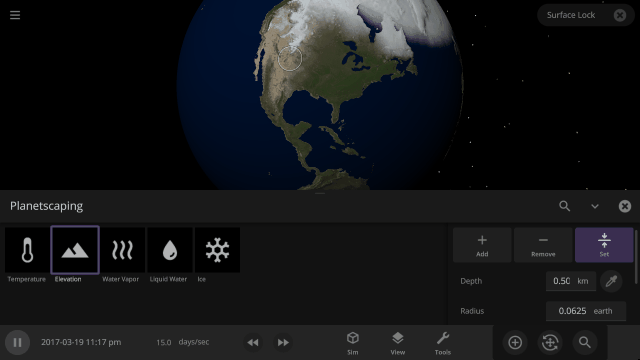
More Highlights
- Surface Lock is now a manual toggle, but turns on automatically when you are using the Planetscaping or Laser Tools
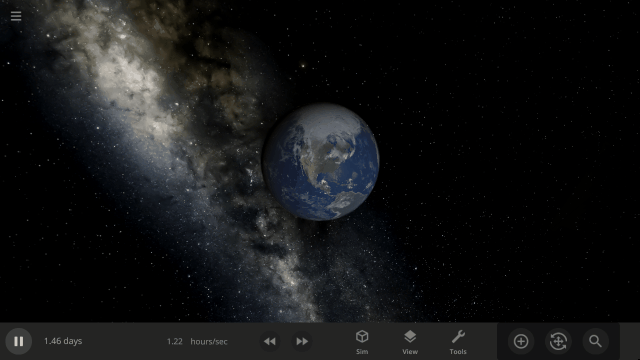
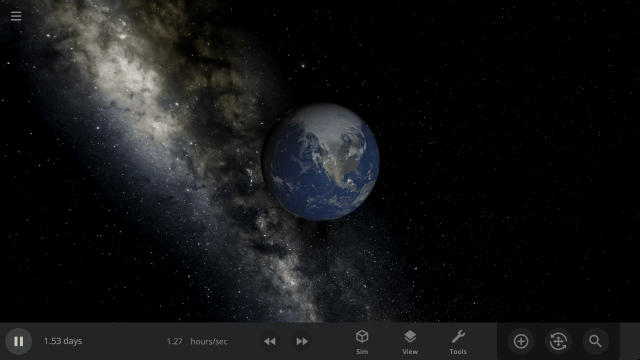
- The Solar System – Live View – Planets, Moons, Spacecraft simulation now has 7 additional spacecraft: Parker Space Probe, BepiColumbo, James Webb Space Telescope, Juno, New Horizons, Voyagers 1 & 2
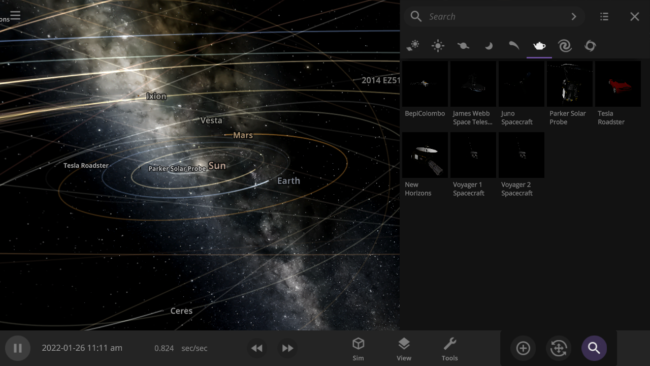
- Here’s a close-up of the James Webb Space Telescope in Universe Sandbox
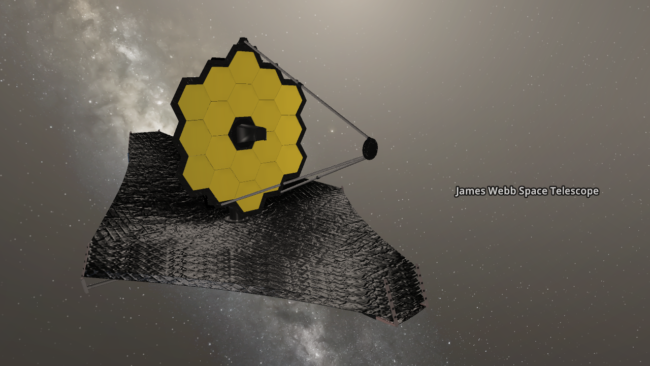
- We’ve polished the look and feel of the Planetscaping and Laser tool cursor
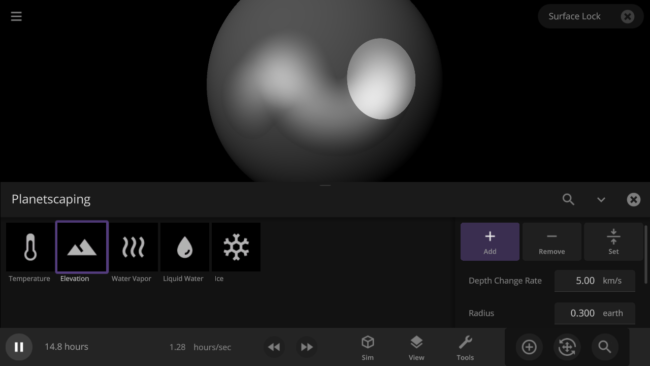
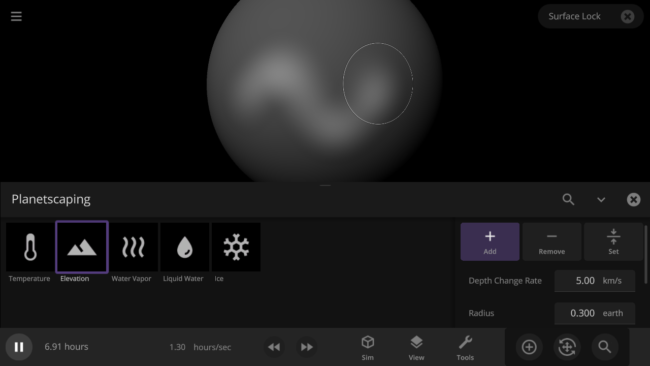
This update includes 3+ additions and 12+ fixes and improvements.
Check out the full list of What’s New in Update 29.1
Please report any issues on our Steam forum, on Discord, or in-game via Home > Send Feedback.

Planetscaping | Update 29
Dec 22nd

Run Steam to download Update 29, or buy Universe Sandbox via our website or the Steam Store.
Update 29
This update introduces Planetscaping, a powerful new way to design and shape planets to your whims. Surface Lock, which gives a clear, stationary, and illuminated view of the surface of a rotating object, has been enabled to better observe how an object’s surface is changing.
Planetscaping (Surface Editing)
Create continents, freeze oceans, flood planets, and more with Planetscaping. Watch the realistic consequences of your actions unfold as you alter the face of planets. Learn more in our Planetscaping guide:
Guides > Tutorials > Planetscaping
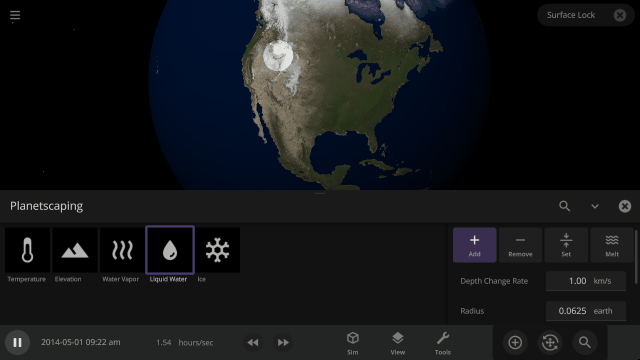
Surface Lock
We’ve made it easier to view how the surface of an object is changing by improving and enabling Surface Lock. This gives a clear, stationary, and illuminated view of the surface of a rotating object when you zoom close to it.
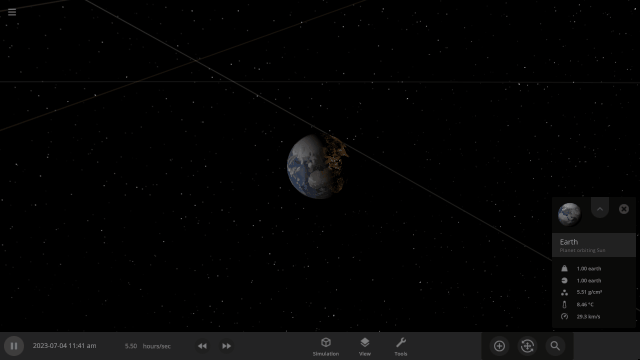
More Highlights
- We’ve added a Blank Planet, like a blank canvas for Planetscaping, to the Add panel
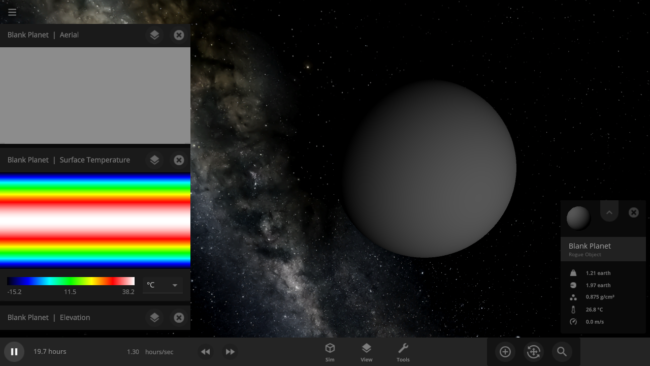
- Collisions have been further improved with updated frictional forces
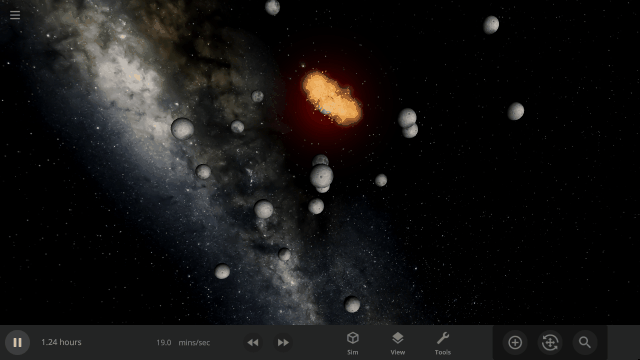
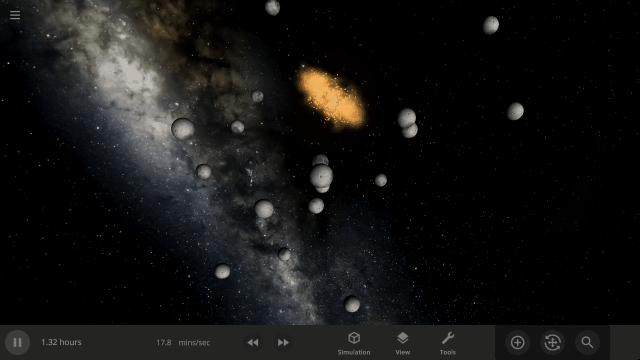
- We’ve exposed the Elevation Span, the distance between the lowest and the highest elevation point of an object, to better assist with Planetscaping
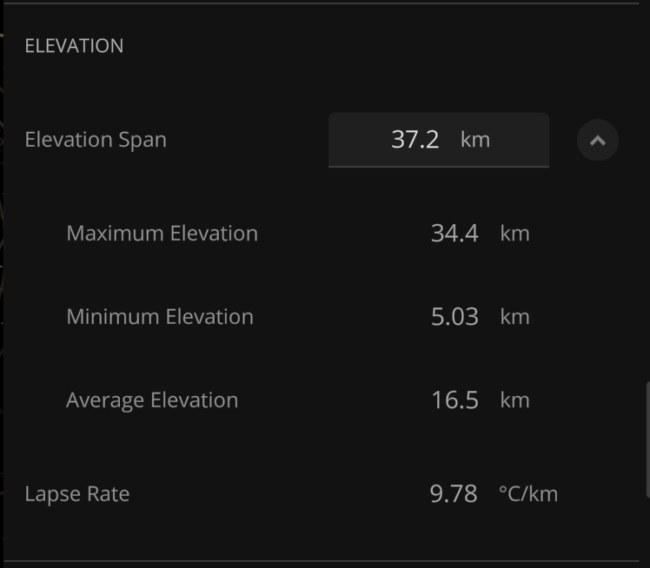
This update includes 5+ additions and 18+ fixes and improvements.
Check out the full list of What’s New in Update 29
Please report any issues on our Steam forum, on Discord, or in-game via Home > Send Feedback.

Starlite Starbrite | Update 28.2
Nov 23rd
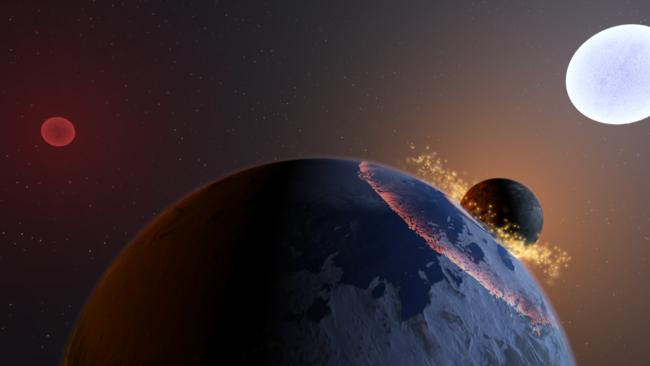
Run Steam to download Update 28.2, or buy Universe Sandbox via our website or the Steam Store.
Update 28.2
Stars have new Absolute and Apparent Magnitude properties, which measure their brightness from different distances. This minor update also includes improvements to black hole collisions, object trails, and bug fixes.
Stellar Magnitudes
Stars now have both Apparent and Absolute Magnitude properties, which are measures of the brightness of a star, under Properties > Temperature. Learn more in our new Stellar Magnitudes guide: Guides > Science > Stellar Magnitudes.
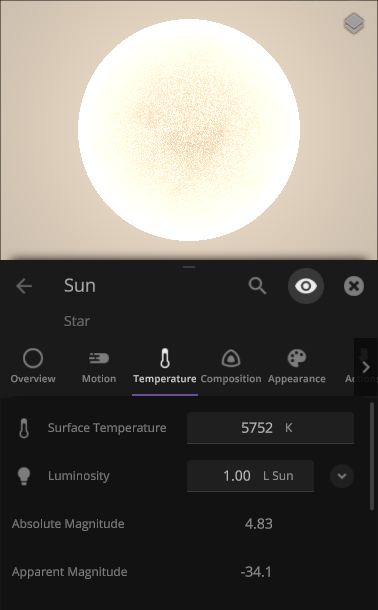
More Highlights
- Colliding black holes now compute the correct Schwarzschild radius
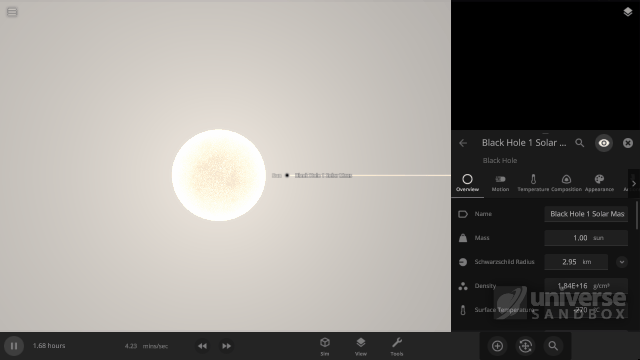
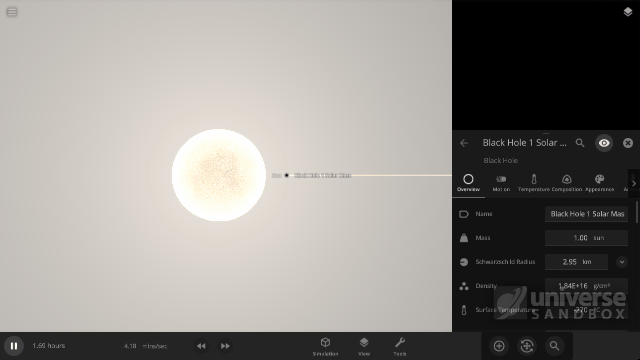
- Trails for objects are no longer broken and jagged when an object is set as the trail center
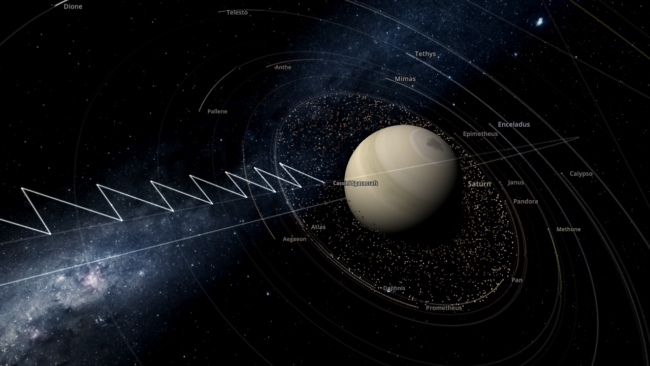
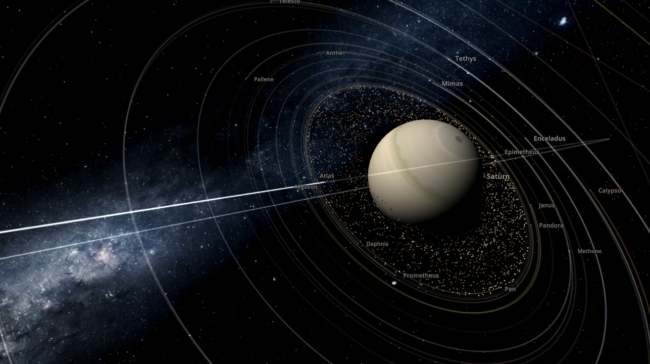
- Starlight color on nearby objects now updates in real-time
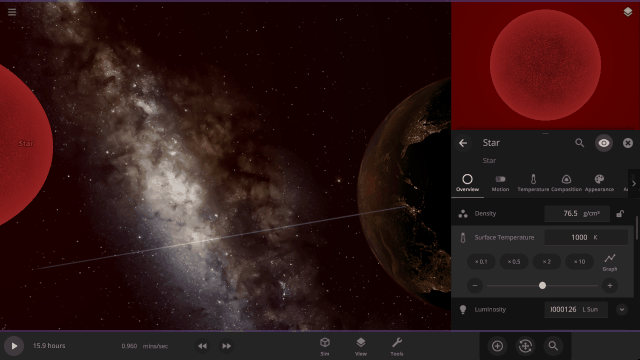
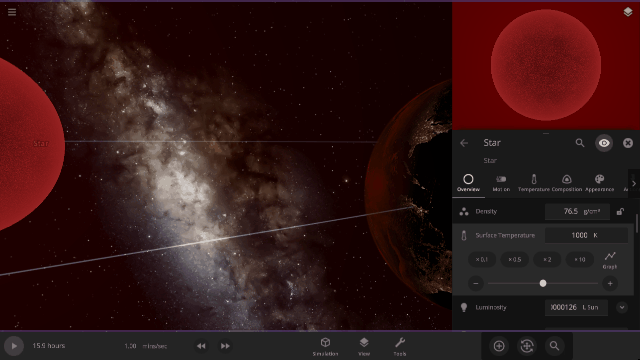
- Human scale objects are now simply heated by stars and supernovae to better reflect their temperature in space
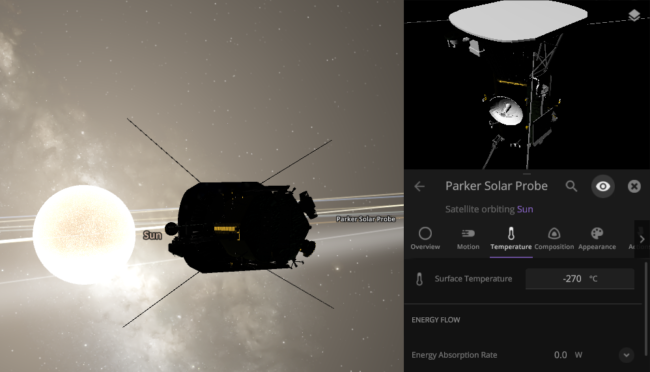
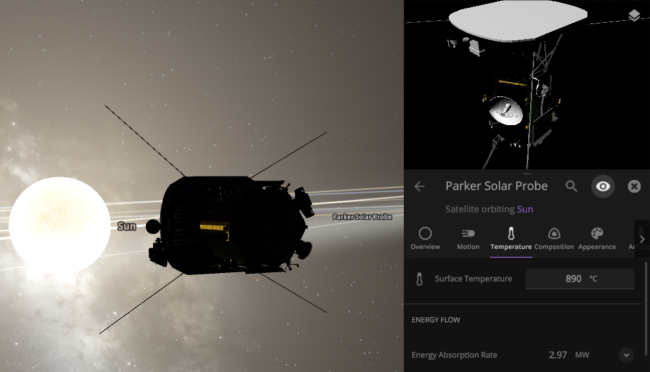
- Created a new guide about object oblateness and its effect on gravitational fields under: Guides > Science > Non-Spherical Gravitational Fields
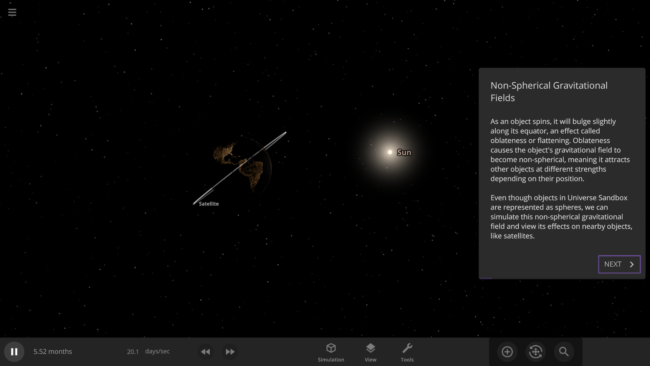
This update includes 3+ additions and 13+ fixes and improvements.
Check out the full list of What’s New in Update 28.2
Please report any issues on our Steam forum, on Discord, or in-game via Home > Send Feedback.

My Eyes, the Space Goggles Do Nothing | Update 28.1
Oct 28th
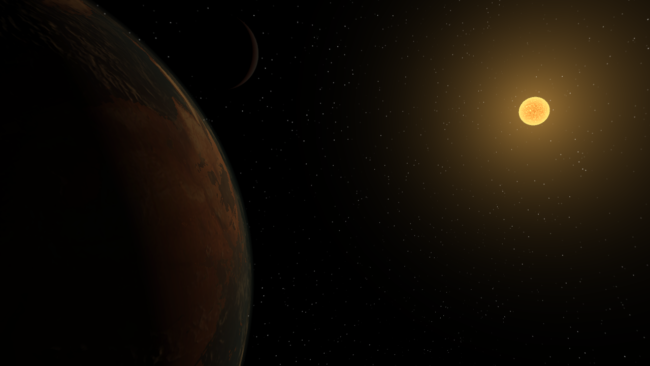
Run Steam to download Update 28.1, or buy Universe Sandbox via our website or the Steam Store.
Update 28.1
We’ve improved the “Realistic” Object Visibility setting to better reflect the sensitivity of the human eye to object brightness and colors. We also added a new “Enhanced” Object Visibility, improved collision detection, smoothed out habitable zones, added bug fixes, and more!
Realistic Object Visibility
The “Realistic” Object Visibility setting now shows objects fading in and out with adjusted colors tuned to what the human eye would see. Learn more in our guide, Limits of Human Eyes.
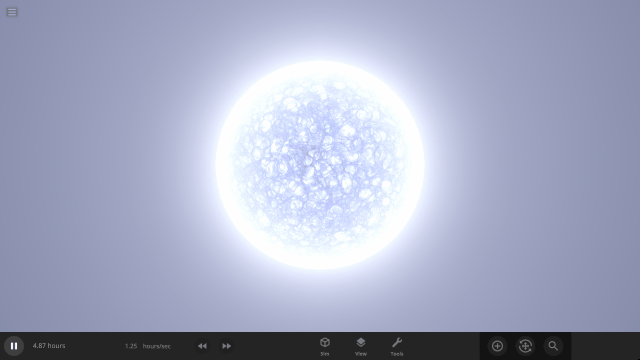
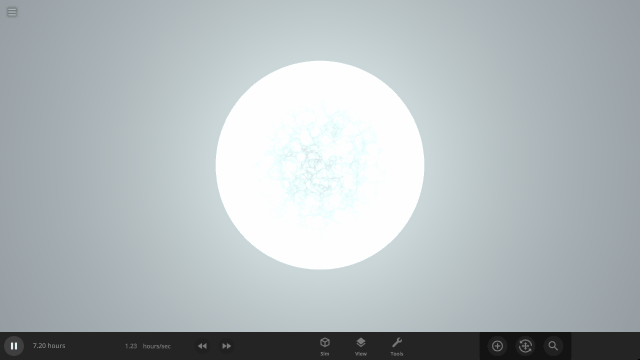
Smoother Habitable Zones
The habitable zone now smoothly changes size for stars of all luminosities, including very hot, bright stars like Rigel. Check it out under View > Habitable.
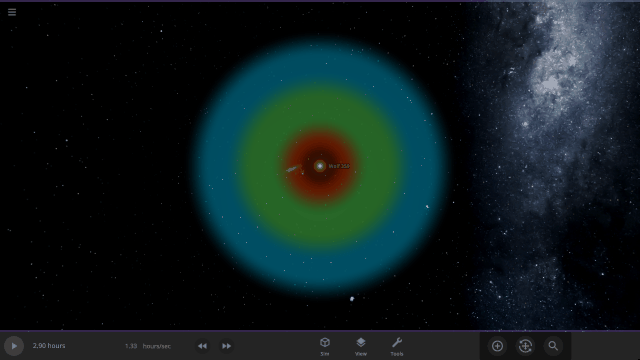
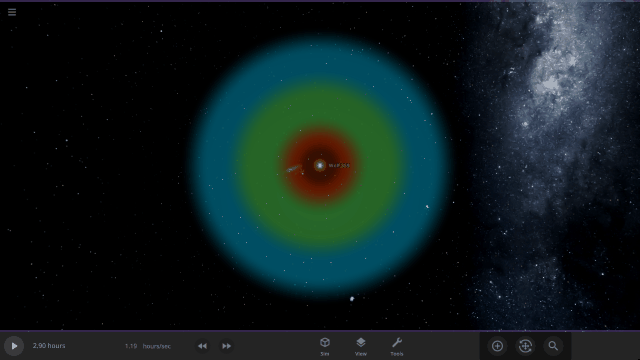
More Highlights
- “Enhanced” has been added as an Object Visibility option, which removes rim lighting from objects while keeping them always visible
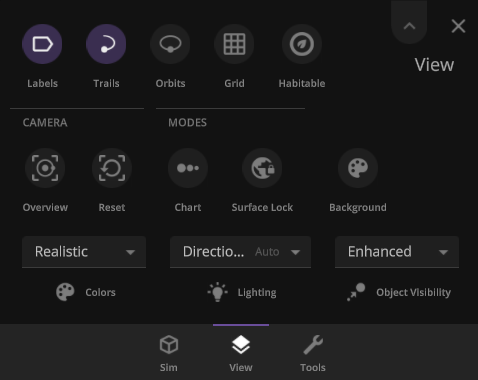
- Collision detection has been further improved as part of our continued work to make collisions even better
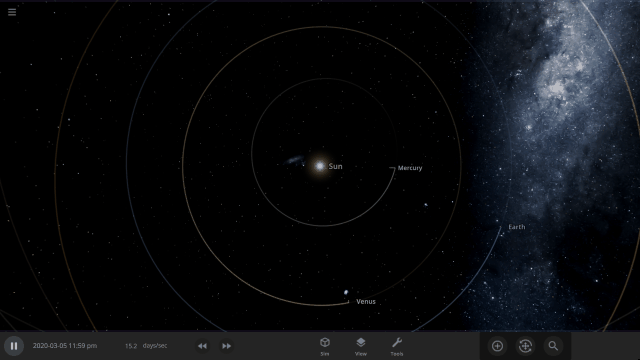
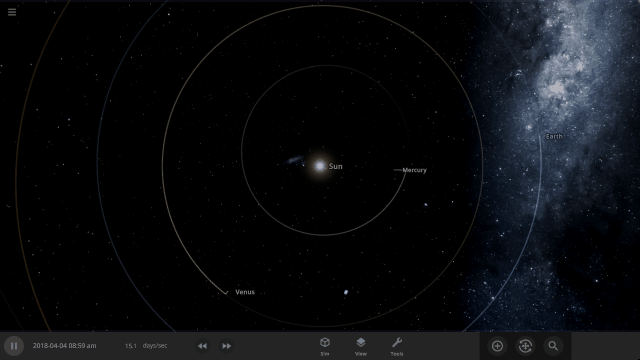
- We’ve added a satellite to our human-scale objects
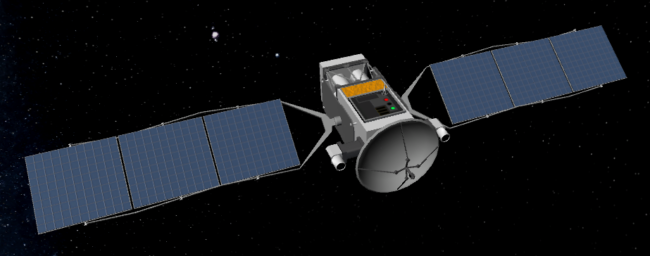
- Created simulation of ESA and JAXA’s BepiColombo spacecraft flyby of Mercury in October 2021: Open > Historical > BepiColombo Flyby of Mercury in 2021
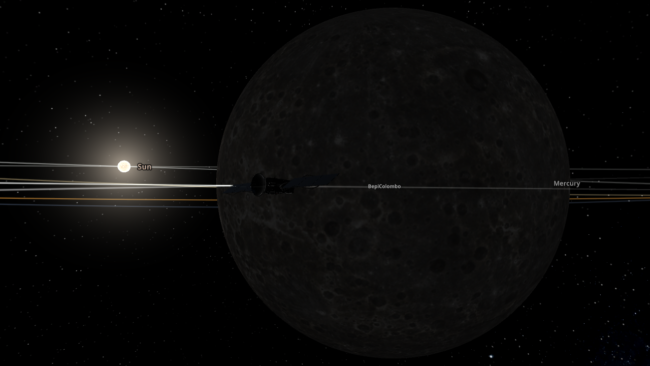
- Open, Guides, and Workshop panels can now be pinned open, allowing for much easier simulation browsing

- The View Settings panel has been reorganized for better clarity and usability
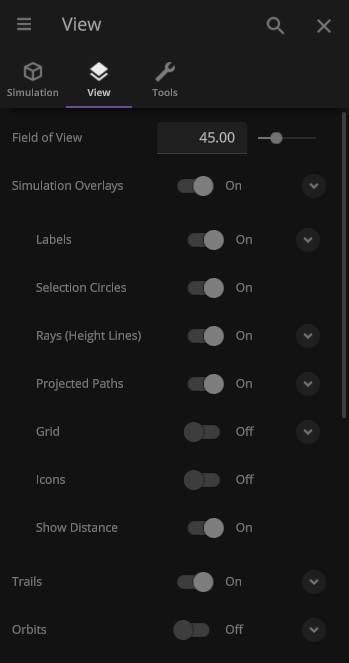
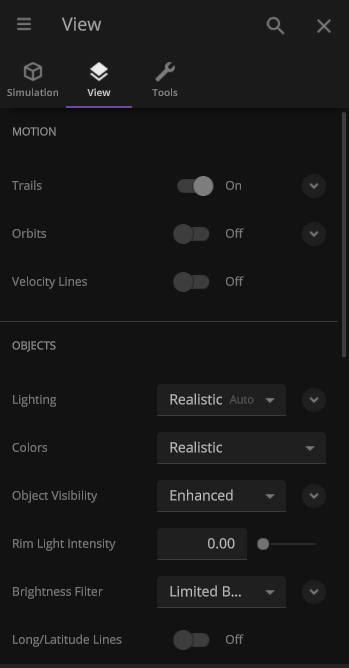
This update includes 6+ additions and 12+ fixes and improvements.
Check out the full list of What’s New in Update 28.1
Please report any issues on our Steam forum, on Discord, or in-game via Home > Send Feedback.

Codename: Fire Ring | Update 28
Sep 23rd
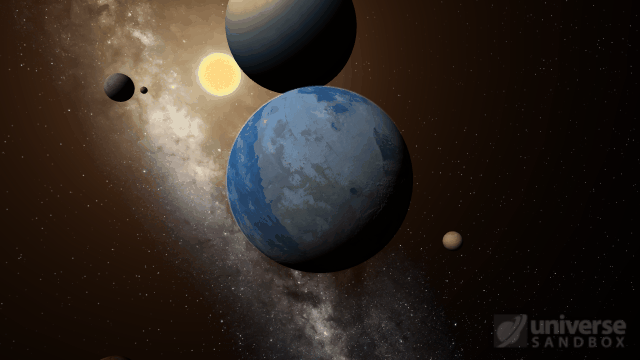
Run Steam to download Update 28, or buy Universe Sandbox via our website or the Steam Store.
Update 28
Fire Ring introduces a collision model that simulates an impact shockwave across the surface of an object, as part of our work to continuously improve collisions. In addition, there are improvements to object trails, additional object information, bug fixes, and more.
Shocking Collisions
Object heating from impacts now realistically moves over the impacted object as a shockwave. Fragments are ejected from the edge of the shockwave at more realistic angles. Learn more in our Collisions guides:
Guides > Tutorials > Planetary Collisions
Guides > Science > Collisions: Energy, Mass, and Speed
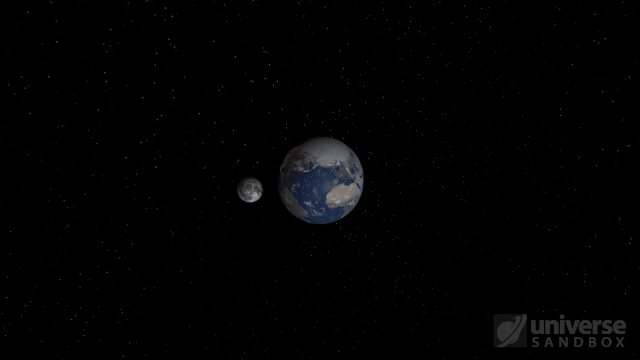
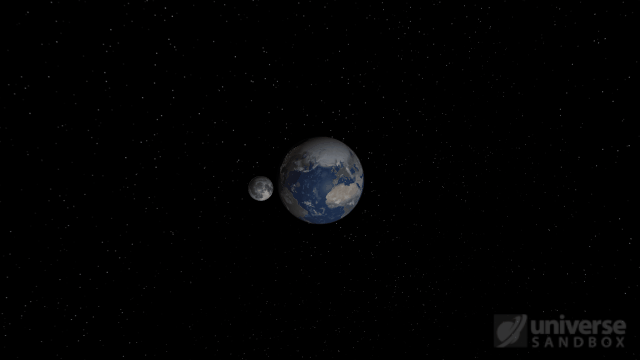
Impactor Heating
Both objects involved in a collision now experience collisional heating on their surfaces, instead of just the larger object.
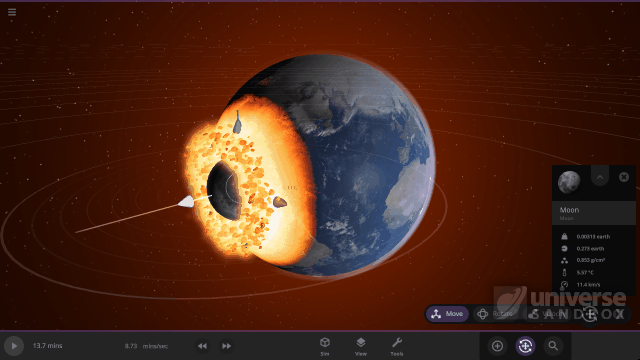
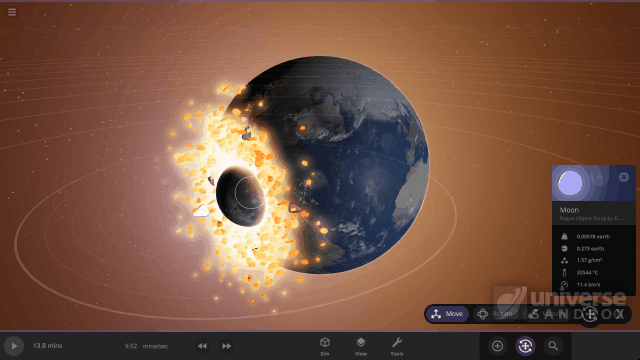
More Highlights
- Grazing collisions now look more realistic with shockwaves and surface dragging
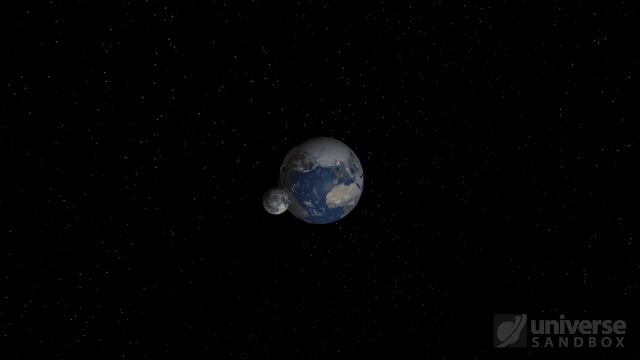
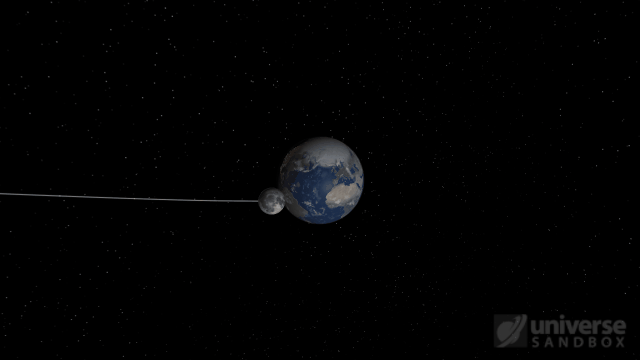
- Object trails are now projected back in time to show their full past trajectory

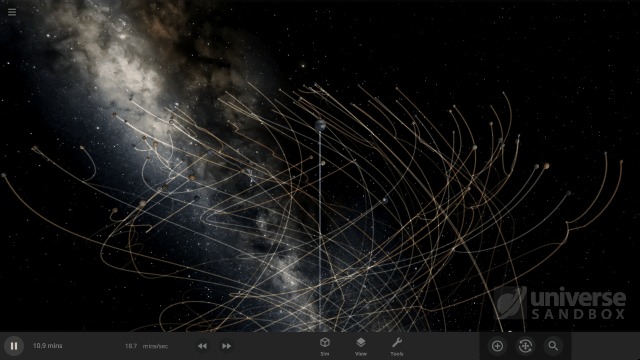
- Objects now have additional information (like, planet, moon, rogue object) in the property panel based on their relative motion around other objects
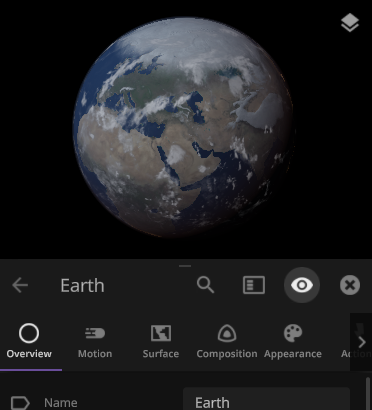
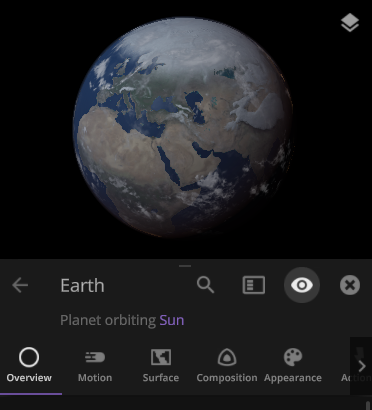
- As we work toward making our simulations more deterministic, seeds for randomized simulations are now easier to find, allowing you to recall previous random scenarios
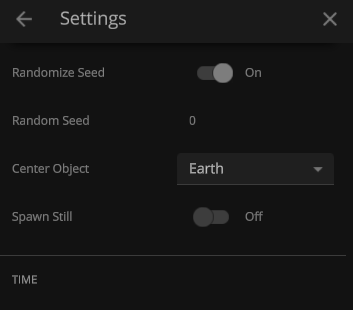
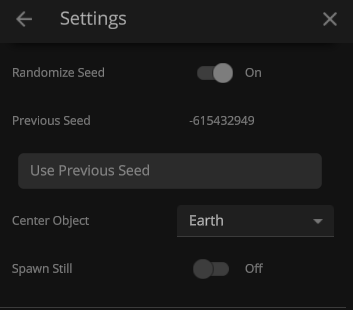
This update includes 6+ additions and 22+ fixes and improvements.
Check out the full list of What’s New in Update 28
Please report any issues on our Steam forum, on Discord, or in-game via Home > Send Feedback.

Universe Sandbox for Mobile | DevLog 1
Sep 10th
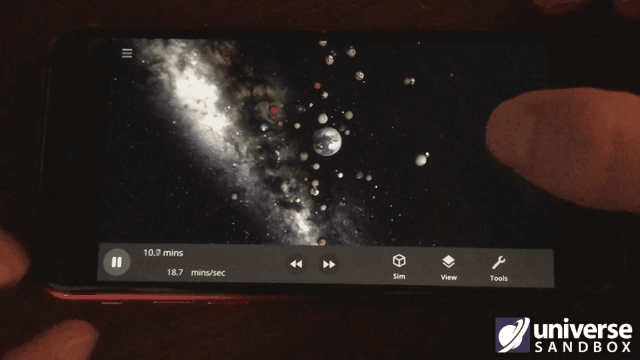
You can purchase Universe Sandbox via our website or the Steam Store.
Have you ever wanted a universe in your pocket? We have too, and so we’ve been actively working on a mobile version of Universe Sandbox for both iOS and Android to make this a reality.
Universe Sandbox for mobile will have the same features and interface as the desktop version (in fact mobile and desktop are built from the same source code) and we are working to make sure it is an equally enjoyable experience.
All-Around Improved Experience
Our work on mobile has motivated many features and improvements that have already been made to the desktop version. This includes automatic scaling of graphics settings based on screen resolution and the separate, minimizable panel that comes up when you use a tool, like the laser. Additionally, optimizing Universe Sandbox for mobile has the added benefit of improving performance on the desktop version.
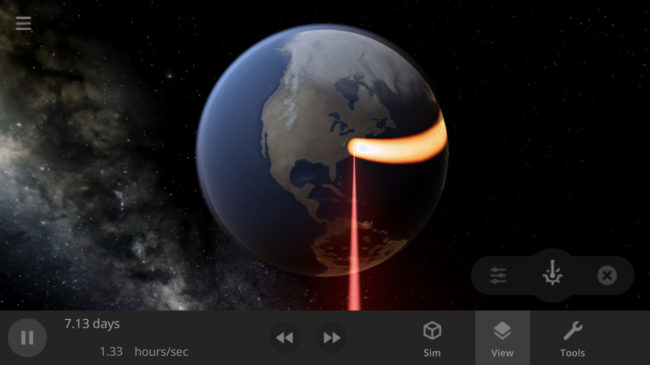
Designing a Handheld Universe Simulator
For the last few months, we’ve been focusing on making sure the mobile version is just as fun to play as the desktop version. In Update 26, we unified the user interface across desktop and VR, and we’re continuing to develop this unified interface with physically smaller (that is, mobile) screens in mind. You can check out how we are building this flexible user interface right now by making the window in the desktop version small. If you do try this, you’ll notice it presents quite a design challenge, not only for existing features but also for any features we add.
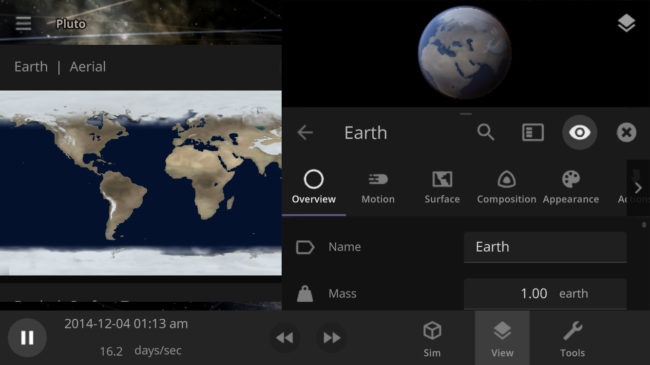
You may have seen some of the improvements we’ve made to our user interface in recent updates. For example, our bottom bar redesigns both create a sleeker, more adaptable desktop experience while also making everything more accessible on mobile. However, we are still working on solving a few design challenges including (but not limited to):
- What’s the best way to manage all of the different panels on a small screen (our guide system creates particular challenges)?
- Working around the limitations of minimum button sizes required for a touchscreens
- How do we make the user interface work in both portrait and landscape orientations?
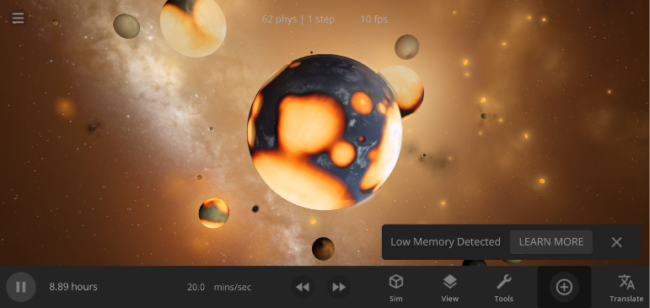
What’s Next for Mobile Development
We have been working on numerous updated user interface designs that improve functionality and clarity no matter what device you are on, and implementing those is one of our major next steps. We’re also currently hiring a cross-platform engineer to help bring Universe Sandbox to mobile and beyond.
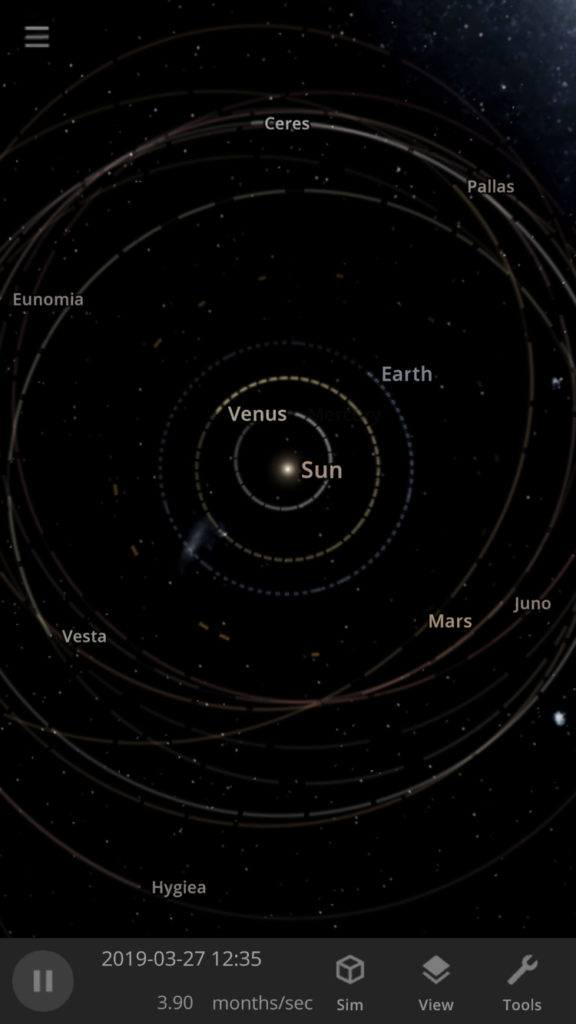
While we still do not have a release date or official price for mobile, we currently plan on it being a one-time paid app with no ads or in-app purchases. We hope to write more of these mobile-focused DevLogs as we make more progress, so stay tuned!
If you want to receive updates when there is new information about mobile, like this DevLog, sign up for our mailing list:
http://universesandbox.com/mobile/
To join our community discussions, please join us on our Steam Forum and our official Discord community

Atmospheric Adjustments | Update 27.2
Aug 2nd
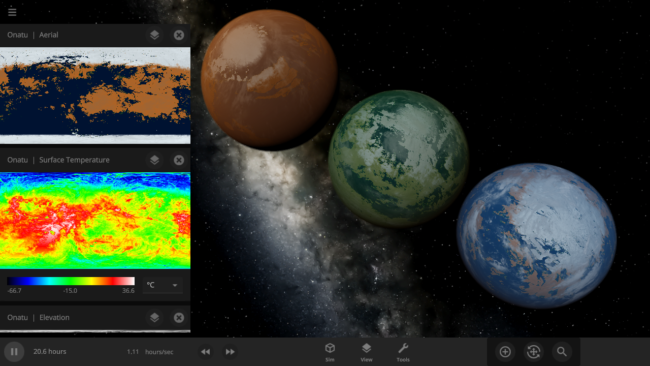
Run Steam to download Update 27.2, or buy Universe Sandbox via our website or the Steam Store.
Update 27.2
You can now change specific simulation interactions, like gravity and collisions, on a per-object basis! This minor update also includes simulated atmosphere opacity (a measure of how hard it is to see through the atmosphere), bug fixes, and more.
Individual Object Simulation Manipulation
The ability to turn off specific simulation interactions on a per-object basis has been added to all objects in Properties > Overview. We plan to add to this over time, and we hope you enjoy creating all kinds of crazy scenarios with these options as much as we do!
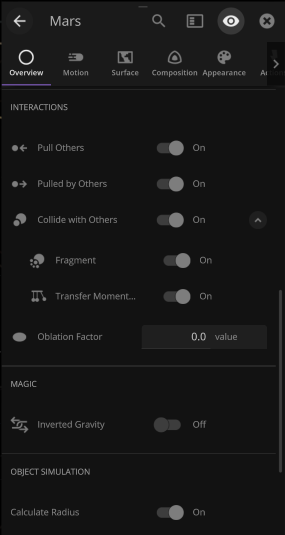
Opaque Atmospheres
Atmosphere Opacity is now simulated based on an object’s properties, like Radius and Atmosphere Mass. Learn more about this new feature in our Atmospheres guide under Guides > Science > Atmospheres.
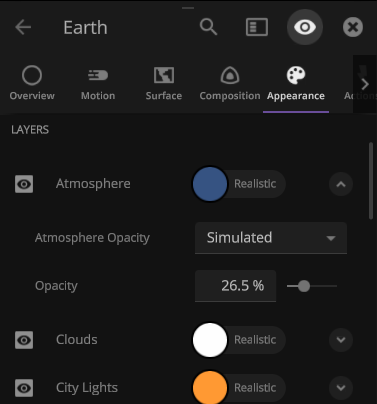
More Highlights
- Polar ice caps on random rocky planets are now informed by the water depth around the poles and are no longer circles
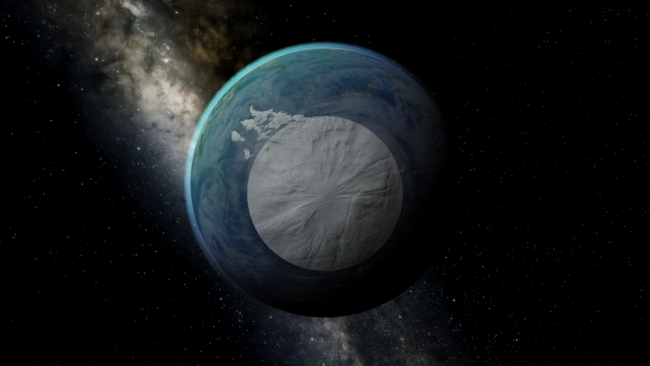
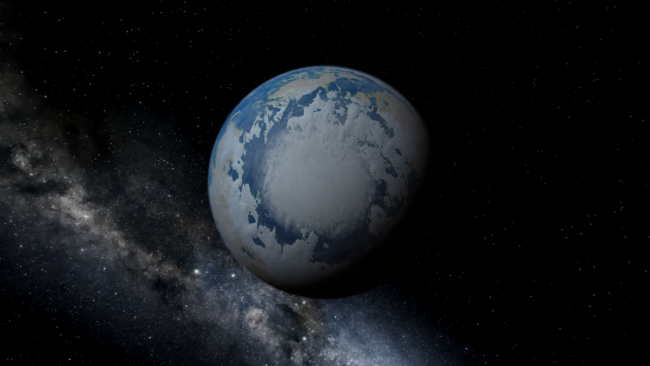
- Opening multiple surface data views no longer causes a noticeable reduction in performance
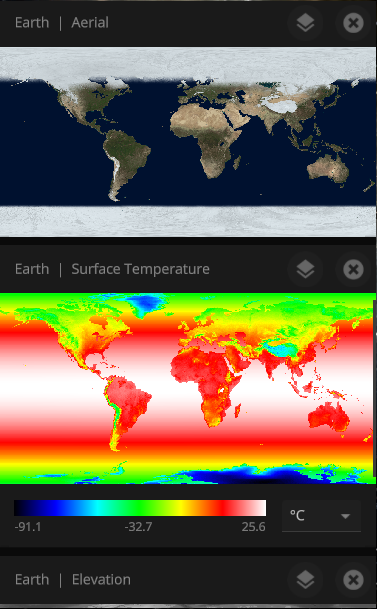
Check out the full list of What’s New in Update 27.2
Please report any issues on our Steam forum, on Discord, or in-game via Home > Send Feedback.

Clouds in Motion | Update 27.1
Jun 21st
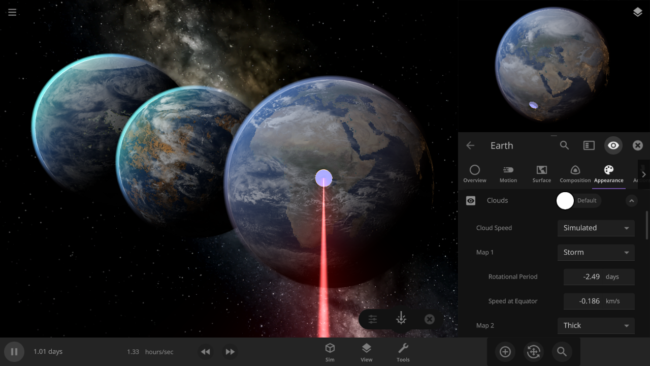
Run Steam to download Update 27.1, or buy Universe Sandbox via our website or the Steam Store.
Update 27.1
Cloud speed is now simulated based on an object’s temperature and rotation speed. Surface simulation performance improvements, an Appearance interface redesign, adjustable planetary rim lighting, and more round out this minor update.
The feature image shows a laser heating up the Earth to speed up the cloud rotation and our new atmosphere opacity property.
Simulated Cloud Speed
Cloud speed is now simulated based on an object’s temperature and rotation speed as part of our continued incremental improvements of clouds. Check out our new Clouds guide for a tour through our entire cloud system: Guides > Science > Clouds.
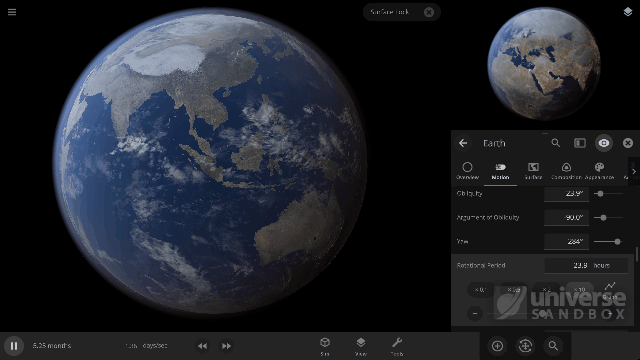
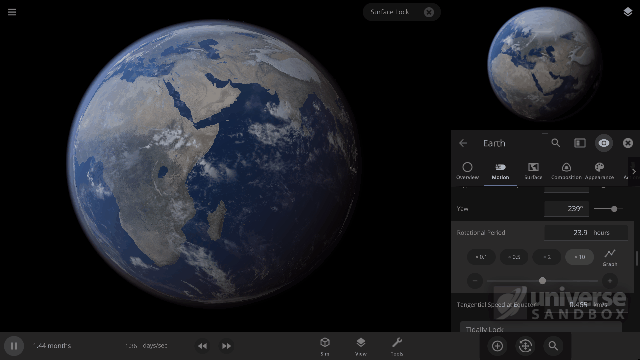
Easier Appearance Editing
As part of our continued user interface improvements, the Properties > Appearance tab has been redesigned to combine color customization with visibility and other options to make changing the appearance of an object even easier.
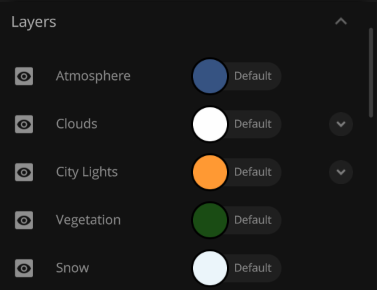
More Highlights
- Surface Simulation has been improved to update only objects that are changing each frame, improving performance for simulations with many objects
- Created simulation of NASA’s Juno spacecraft flyby of Ganymede in June 2021: Open > Historical > Juno Flyby of Ganymede in 2021
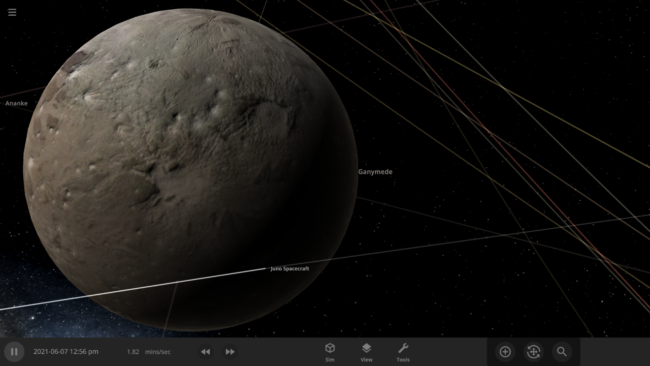
- Star glows correctly fade as you get farther away from them when Object Visibility is set to Realistic again
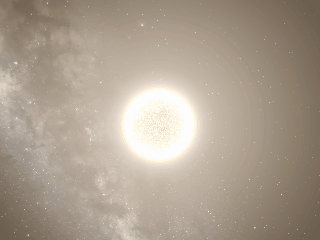
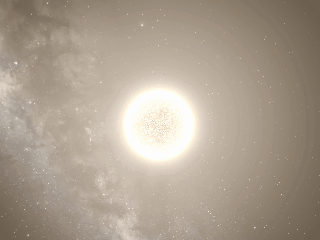
- Added Atmosphere Density and Speed of Sound Properties to Properties > Surface > Atmosphere
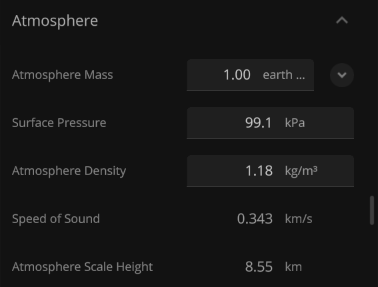
- Rim Lighting can now be adjusted under View > Object Visibility > Rim Lighting
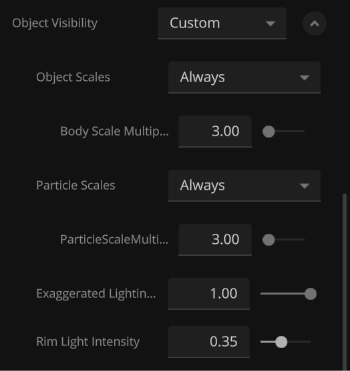
Check out the full list of What’s New in Update 27.1
You can also check out our 2021 Roadmap to learn more about what we’re currently working on!
Please report any issues on our Steam forum, on Discord, or in-game via Home > Send Feedback.

Universe Sandbox Roadmap: 2021.5 & Beyond
Jun 16th
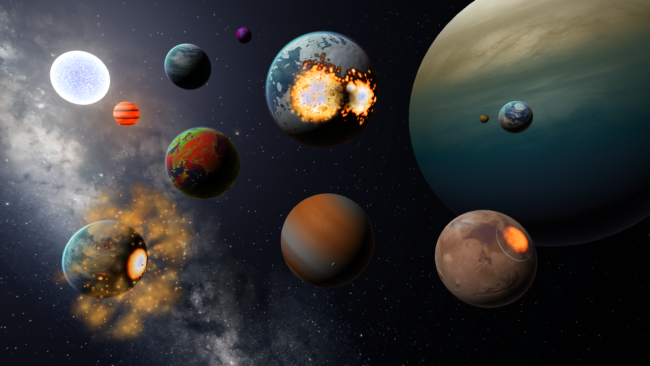
Last year we worked hard to make Universe Sandbox even better, and we’ve continued that work into this year with two updates already. We wanted to share some of the exciting plans we have for upcoming features including terrain manipulation, an expanded materials system, and more, that we have for the rest of the year (and a bit beyond).
What did we do in 2020?
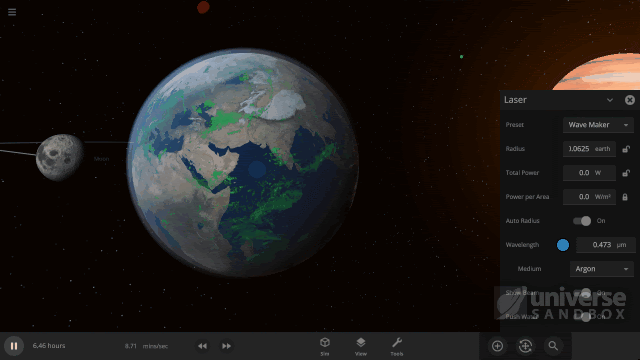
In 2020 we had two major updates and a few minor updates as well.
- I Like My Heat Tidal | Update 25
- Rewrote the tidal heating model and temperature calculations
- Major graphics performance improvements which allowed us to improve surface simulation
- Light It Up | Update 25.1
- Added randomizable city lights to all planets
- Improved how multiple light sources interact, particularly with atmospheres
- Even More Colors in Space | Update 25.2
- Even more custom color options for clouds, city lights, asteroids, and galaxies
- Improved energy calculations even more with laser, explosions, and impacts
- Reimagined Experience – Unified VR & Desktop | Update 26
- We brought the full desktop experience into VR
- Reimagined user interface with a customizable bottom bar
- Better looking collision fragments, rocky planets, and liquid water
- Star Fusion & the Brown Dwarves | Update 26.1
- Smoother simulated transitions between gas giant, brown dwarf, and full fledged star
- More customizable colors and laser improvements, including the “Wave Maker” laser
- Ending 2020 with a Bang | Update 26.2
- Objects retain lasting surface damage with craters and scorched areas
- More realistic explosions with better simulated gas particles
View our “What’s New” for a chronological list of changes.
What have we already done in 2021?
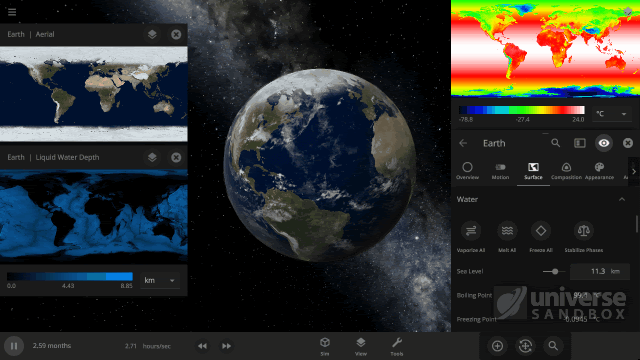
This year has already seen two notable updates that have included many fixes to our core simulation, a few new features, and improvements to the Universe Sandbox experience.
- Splish, Splash, Filling a Bath | Update 26.3
- Water fills from lowest points and flows to lowest points
- Smoother, better performing, and explodi-er collisions
- Fast & Flurrious | Update 27
- More realistic snow simulation and better looking random rocky planets
- Added a separate elevation adjusted surface temperature map
- New Render Scale settings to improve performance for non-gaming hardware
New team members
Brent was hired in March as our new Science Writer & Community Advocate. Brent has a PhD in Physics and will be writing about all of the awesome science and simulations that Universe Sandbox can do (including writing this post – Hi Everybody 😃 ).
We also recently hired Brian as our new User Interface Engineer. Brian joins us after working as a frontend web engineer, and is excited to help make Universe Sandbox the best possible experience for exploring space and science. He’ll be implementing some of the many, many user interface designs we’ve been working on.
What’re we currently working on?
You’ve seen some of what we’ve been up to this year from the updates we’ve put out already, but there’s still a lot of new features in development. While we would love to get all of these new features and improvements out by the end of the year, there may be new priorities or unexpected difficulties that pop up, which make it hard to predict exactly when we will have these features ready.
Surface Grids & Planet Appearances
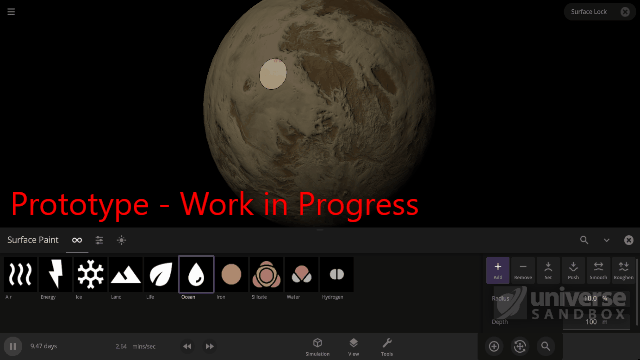
The simulation of temperature, ice, water, vapor, and other properties across the surface of an object, a feature we call Surface Grids, has become a fundamental part of Universe Sandbox. Read more about Surface Grids in our DevLog and ScienceLog series. Yet even with all of the improvements we made to them last year, there is still so much that can be done.
- Planet Surface Editing
- Last year we did a bit of work designing and determining the best way to add tools that will allow you to directly edit the surface properties of an object, and we’re hoping to implement those tools this year.
- You’ll be able to change your planet’s elevation, water level, temperature, and more with single point precision on the surface grid.
- Improved Atmosphere Simulation
- With many improvements in performance in Update 26.3, we are looking into extending the atmosphere of planets into the surface grids simulation.
- Better simulated atmospheres will allow for more realistic climate and cloud simulation.
- Fiery Collisions
- We plan to build upon the collision improvements introduced in Update 26.3 with more realistic post-impact shockwaves, fragmentation, and grazing impacts.
Enhanced User Interface
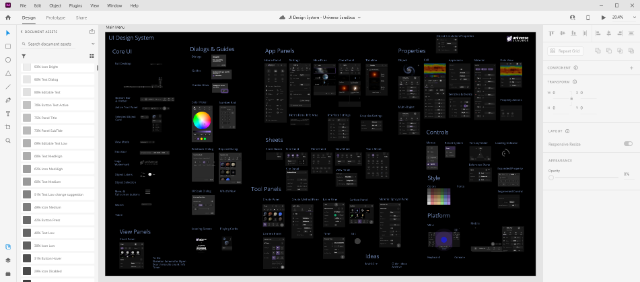
Our goal for each update to Universe Sandbox is to improve your experience. This might involve updating our user interface, improving our guides for new users, increasing performance, and other small tweaks.
- Towards a Forward-Thinking User Interface
- We’ve taken a responsive design approach that lets the interface work universality across desktop, mobile, VR, and future-gamepad support in mind.
- We already redesigned the Add panel in Update 27 and unified the styling in preparation for future tools and features, like the surface enhancement tools we mentioned above.
- The Most Enjoyable Experience
- In addition to guide rails, which help walk users through our tutorials, that were added in Update 27, we want to update and add more guides and science simulations for new and old users alike.
…and Beyond?
In addition to all of these plans, we also have some longer-term goals, and though many of these may not happen for a while, we wanted to share with you.
Multiple & Mixed Materials
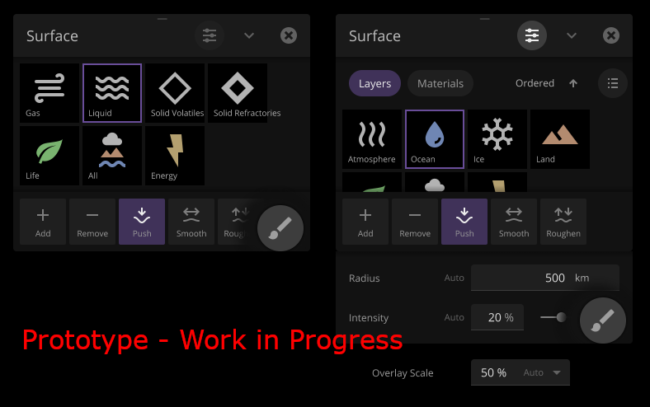
We want to give you access to more basic materials, like methane, CO2 (carbon dioxide) and O2 (oxygen), to our current system. Not only will a more robust material system allow you to further customize your planets, moons, and asteroids, but it will also make future features, like Life Simulation and realistic atmosphere simulation, possible.
- A Material World
- More materials will allow for more planet customization and allow more versatility in terraforming planets. They will also allow you to customize your planet’s atmosphere — will it be suitable for life, or mostly composed of methane like Titan?
- Multiple materials will be critical for developing life simulation in the future. Life is made up of complex materials after all.
- Unified Materials System
- Our goal is to track all the different materials, and the state that they’re in, in each point in a surface grid on planet surfaces.
- Keeping track of all of these materials and their properties will allow for more realistic simulation calculations in general, like the phase state (solid, liquid, gas) changes for all of our new materials.
Rigid Body Physics
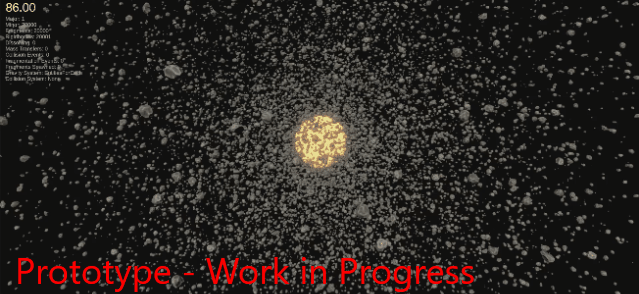
Currently our physics engine isn’t optimized for rigid body physics required for proper human scale (like dice and spacecraft) object interactions. We’re working to change that and have been researching different methods of implementing a whole new suite of physics into Universe Sandbox.
- DOTS-based Unity Physics
- Unity has introduced a promising new physics engine that we’ve been spending time researching. Based on the Unity DOTS (Data Oriented Technology Stack) framework, the new Unity Physics engine promises significantly better performance.
- This DOTS-based Unity Physics would not only enhance our rigid body physics, but would also be used to improve the performance of our gravity simulation.
- To Infinity and Beyond
- Much like Surface Grids, rigid body physics lays the foundation for many simulation features to come, such as spacecraft, thrusters, and megastructures.
- Having more bodies that follow these new physics will also allow you to better simulate how larger bodies form as smaller objects clump together. Make planets out of asteroids, or pigeons, it’s up to you.
Mobile
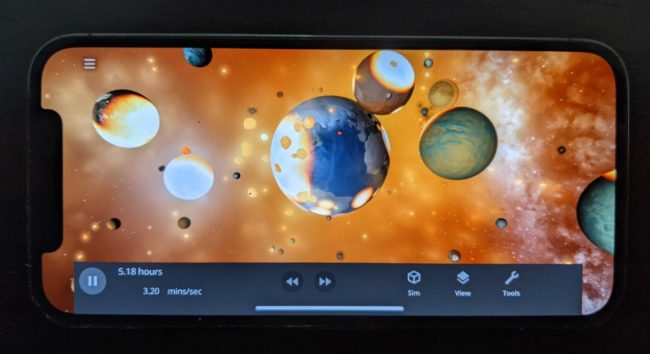
We’re still actively working on a mobile release for both iOS and Android, though there’s still many design questions to be answered.
- The Full Experience on Mobile
- When we bring Universe Sandbox to mobile, we plan to bring the full desktop version to mobile so you’ll have access to all the same features, just in your pocket!
- A smaller screen means our user interface will need to be even more innovative, and we’re working hard to make sure that the mobile experience is just as fun to play as it is on a desktop.
And More
There’s no shortage of additions and improvements to be made when you’re simulating the Universe! We’re also thinking about future features like Lagrange points, atmospheric scattering, and life simulation, and we’re excited to share them all with you!
Hiring
We’re currently hiring another Physics Engineer, join us!
Answering Some of Your Questions (Addendum)
We’re really glad that you all enjoyed reading our Roadmap. You asked a lot of good questions and we wanted to answer some of them here:
1. Will you be able to export (and import) height maps for celestial objects?
We plan to support importing and exporting of surface maps, but we don’t yet know when that will happen.
Much of the surface data (like elevation and color) that we use for known solar system objects is based on data available online. You can find similar maps to the ones we use online, like this set of Moon elevation and color maps (though these are not exactly what we use).
2. What materials are you planning on adding?
Development of adding additional materials to the simulation is still in flux. Our goal is to add all the basic materials that are necessary for simulating basic life like carbon dioxide and oxygen, as well as some others like methane and sulfur, which are found in large quantities on other planets and moons in the solar system.
3. Will we be able to make planets out of any materials?
Great question. When we add additional materials to Universe Sandbox, we are planning to make them available as part of an object’s Composition properties, similar to our current system, so you’ll be able to make planets out of any material we add.
4. Will we be able to make megastructures like Death Stars?
We think this would be really fun, and actually have this on our Roadmap already. The general idea would involve a separate system to build megastructures like Dyson Spheres (or even Death Stars). However we still have a lot to do before we start work on that.
5. Are we adding sentient life as part of our life simulation?
That is a cool idea. We’re still a ways away from even the simple life simulation we are hoping to implement though. The first version of life simulation will likely be a surface map, similar to our other surface grid maps, that would show “amount of biomass” or “vegetation,” but we don’t have all of the details worked out yet.
6. Any plans to make the game run in Vulkan?
While we don’t have any plans right now to support Universe Sandbox for Vulcan, an API for graphics rendering and computing (different from what we currently use), on Desktop, that doesn’t mean we won’t look into it in the future.
7. Will we be adding continental drift or volcanoes?
Right now we don’t have any plans to add either of these features, though we have thought about adding very simple volcanoes in the past. There are a lot of improvements and fixes we need to make to the core features before we think about adding in complicated features like that.
8. Is there a way to beta test new features?
Yes! We will occasionally release Community Test builds to get feedback on new features and help us find bugs. We announce when these go live in a post on the Steam Forums and on our Discord server.
9. What devices will Universe Sandbox mobile be available on and will it be free for those who have already bought Universe Sandbox?
Universe Sandbox will be available on both iOS and Android devices. Minimum device requirements have not been finalized yet.
We still do not have a release date or official price for mobile, but we do plan on it being a one-time paid app with no ads or in-app purchases. The desktop and the mobile versions will be sold on separate stores and will be separate purchases. If you want Universe Sandbox on your mobile device you will need to purchase from the mobile store, even if you already own Universe Sandbox on desktop.
10. Are we still working on Smoothed-particle Hydrodynamics (SPH)?
We have shifted our focus on fixing problems and bugs with the fundamental systems and simulation before resuming work on awesome new features like SPH. That said, we still want to do SPH, but are actively working on improvements to the current collision system that we discussed in the Roadmap.
Learn more about SPH in our SPH blog post.
Updated July, 15, 2021

Fast & Flurrious | Update 27
May 3rd
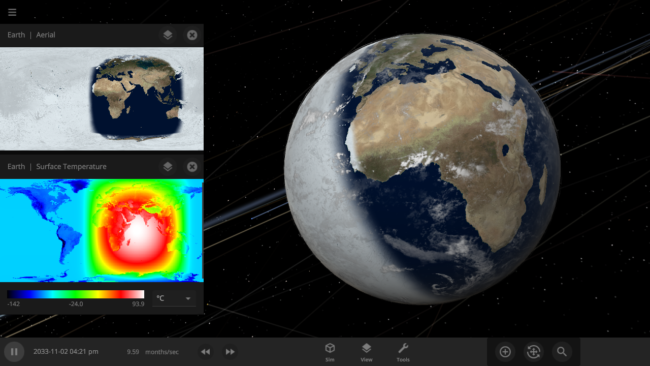
Run Steam to download Update 27, or buy Universe Sandbox via our website or the Steam Store.
Update 27
Snow simulation improvements, more detailed temperature maps, better performance, new cloud visuals, and more are rolled up into Update 27.
The featured image shows what would happen if the Earth was tidally locked, where one side of the planet always faces the Sun.
Superior Snow Simulation
We’re now keeping track of snow so that it falls and melts more realistically. Previously it disappeared immediately if the water vapor got too low. There’s also more accurate snow and ice formations on newly-created random rocky planets!
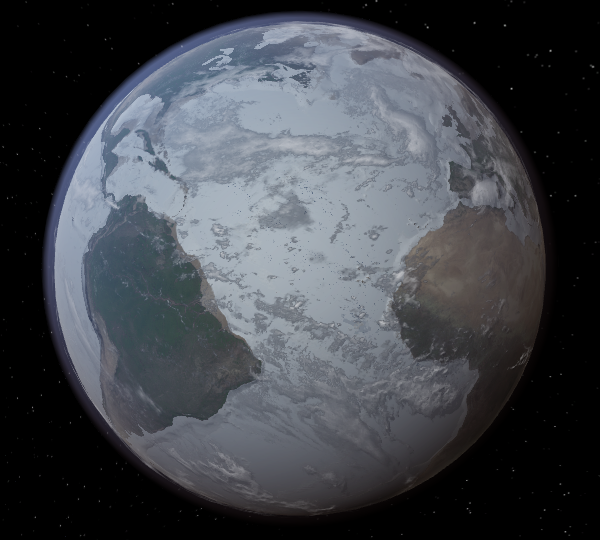
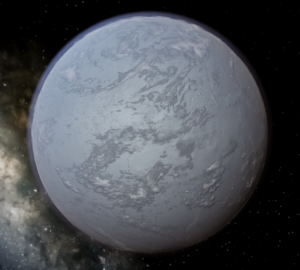
Taking the (Surface) Temperature
Temperature maps have gotten a facelift with the addition of temperature calculations adjusted by elevation. Previously temperature maps were only shown at sea level, even if the elevation data was above sea level.
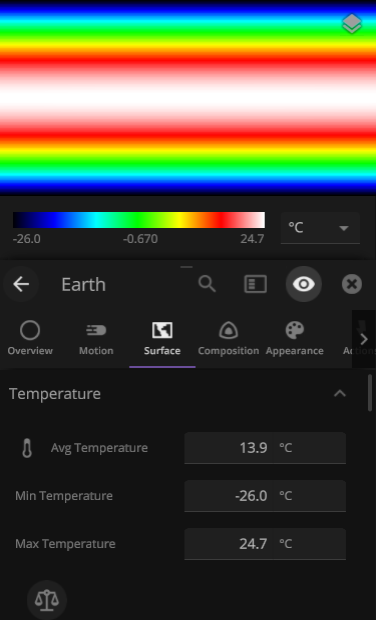
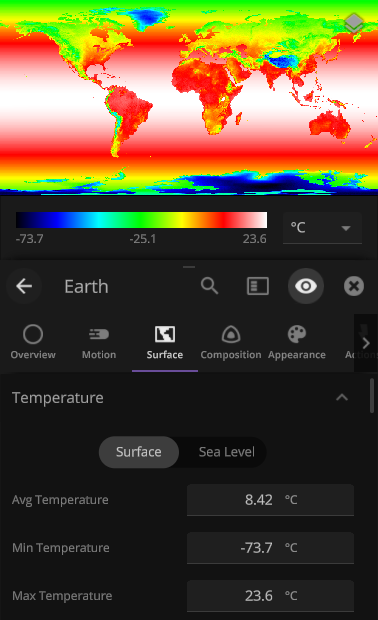
Downscaling to Benefit Non-gaming Hardware
Render Scale has been added as a new graphics setting. This allows you to run the simulation at a lower resolution while keeping the interface looking crisp. The automatic settings have also been updated for improved performance on lower-end hardware.
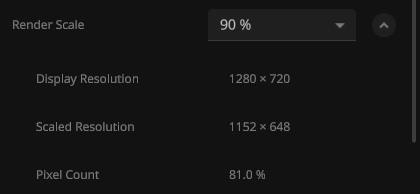
More Highlights
- More customization for cloud visuals on rocky planets, including adjustable coverage and opacity
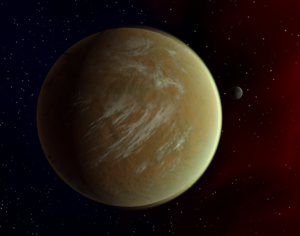
- We’ve added new shapes to our Human Scale Objects
- …and Human Scale Objects can now have custom colors

- View > Object Visibility has been added so that you can see all objects that would normally be impossible to see at realistic scales. You can also really blow them up with advanced settings!
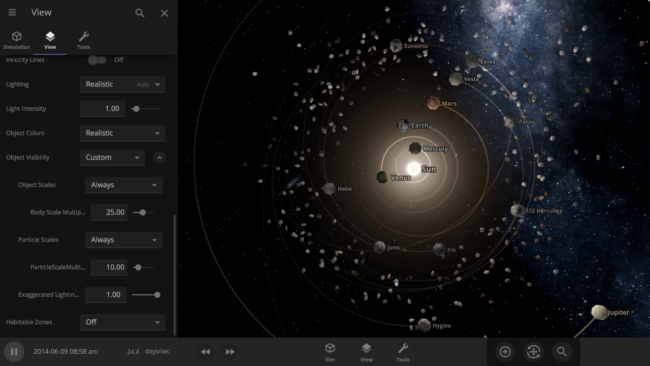
- The Add Panel has been restyled to accommodate smaller screens and to prepare the panel for future plans

- Heating from stars and supernovae is now smoother at high simulation speeds for all spinning objects
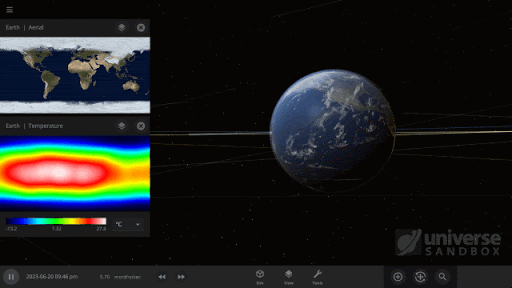
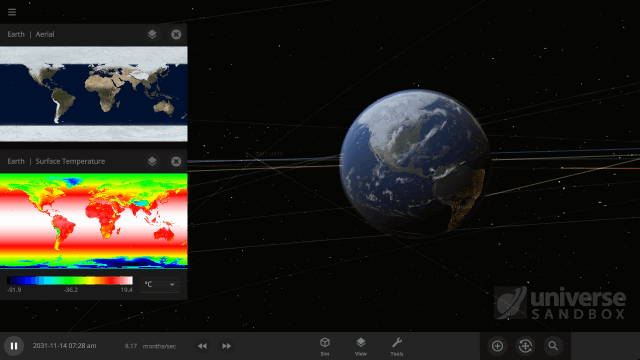
- Our guide system now provides better assistance to new users with Guide Rails
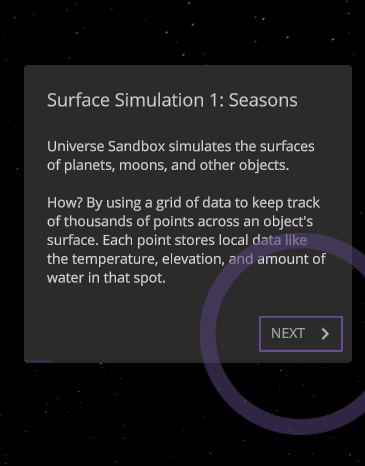
- Curved trails are now more precisely rendered as at high simulation speeds
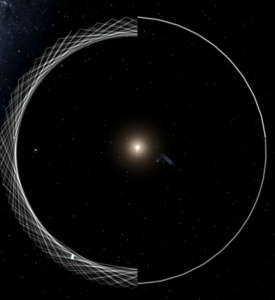
- Dyslexia-friendly font options have been added under Settings > General > Accessibility
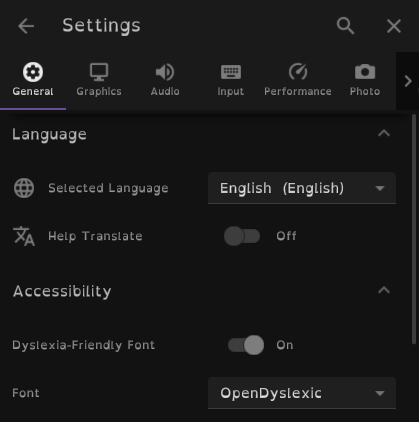
Check out the full list of What’s New in Update 27
Please report any issues on our Steam forum, on Discord, or in-game via Home > Send Feedback.
